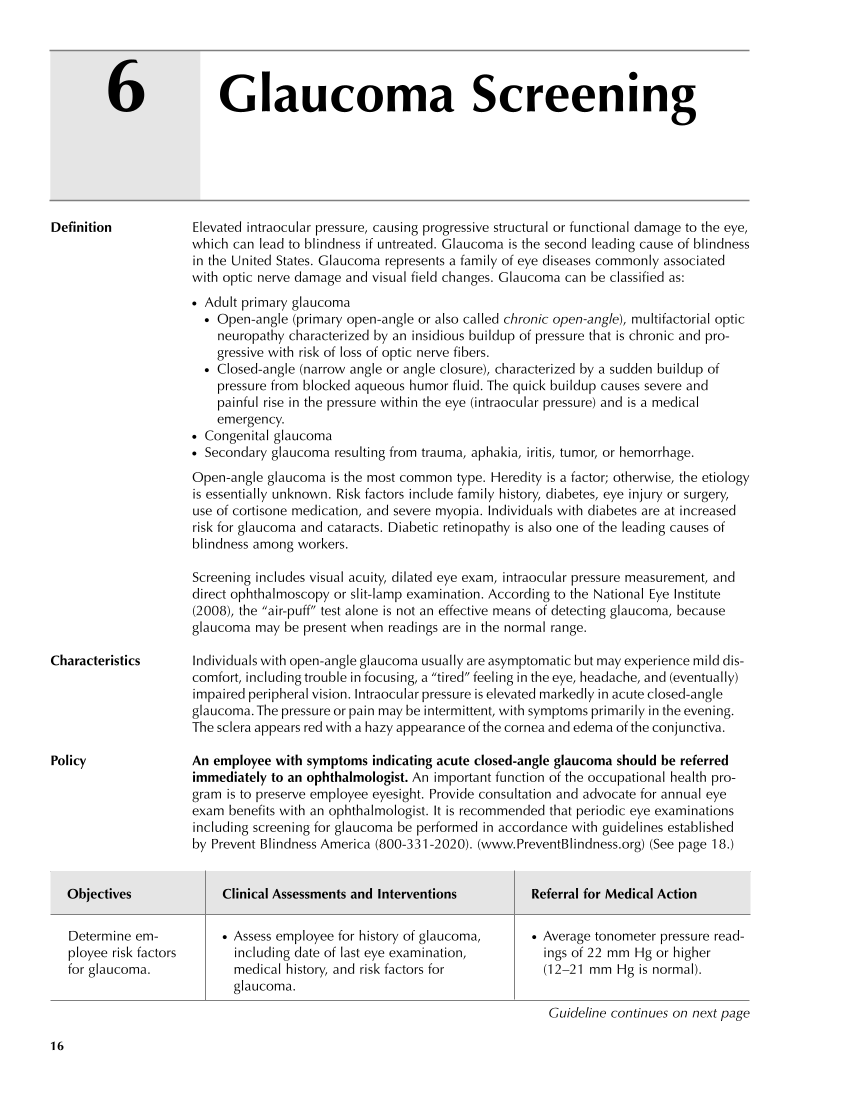6 16 Definition Elevated intraocular pressure, causing progressive structural or functional damage to the eye, which can lead to blindness if untreated. Glaucoma is the second leading cause of blindness in the United States. Glaucoma represents a family of eye diseases commonly associated with optic nerve damage and visual field changes. Glaucoma can be classified as: ● Adult primary glaucoma ● Open-angle (primary open-angle or also called chronic open-angle), multifactorial optic neuropathy characterized by an insidious buildup of pressure that is chronic and pro- gressive with risk of loss of optic nerve fibers. ● Closed-angle (narrow angle or angle closure), characterized by a sudden buildup of pressure from blocked aqueous humor fluid. The quick buildup causes severe and painful rise in the pressure within the eye (intraocular pressure) and is a medical emergency. ● Congenital glaucoma ● Secondary glaucoma resulting from trauma, aphakia, iritis, tumor, or hemorrhage. Open-angle glaucoma is the most common type. Heredity is a factor otherwise, the etiology is essentially unknown. Risk factors include family history, diabetes, eye injury or surgery, use of cortisone medication, and severe myopia. Individuals with diabetes are at increased risk for glaucoma and cataracts. Diabetic retinopathy is also one of the leading causes of blindness among workers. Screening includes visual acuity, dilated eye exam, intraocular pressure measurement, and direct ophthalmoscopy or slit-lamp examination. According to the National Eye Institute (2008), the “air-puff” test alone is not an effective means of detecting glaucoma, because glaucoma may be present when readings are in the normal range. Characteristics Individuals with open-angle glaucoma usually are asymptomatic but may experience mild dis- comfort, including trouble in focusing, a “tired” feeling in the eye, headache, and (eventually) impaired peripheral vision. Intraocular pressure is elevated markedly in acute closed-angle glaucoma. The pressure or pain may be intermittent, with symptoms primarily in the evening. The sclera appears red with a hazy appearance of the cornea and edema of the conjunctiva. Policy An employee with symptoms indicating acute closed-angle glaucoma should be referred immediately to an ophthalmologist. An important function of the occupational health pro- gram is to preserve employee eyesight. Provide consultation and advocate for annual eye exam benefits with an ophthalmologist. It is recommended that periodic eye examinations including screening for glaucoma be performed in accordance with guidelines established by Prevent Blindness America (800-331-2020). (www.PreventBlindness.org) (See page 18.) Objectives Clinical Assessments and Interventions Referral for Medical Action Glaucoma Screening Guideline continues on next page ● Average tonometer pressure read- ings of 22 mm Hg or higher (12–21 mm Hg is normal). Determine em- ployee risk factors for glaucoma. ● Assess employee for history of glaucoma, including date of last eye examination, medical history, and risk factors for glaucoma.
Purchased from OEM Press by (ge corporate access). (C) 2013 OEM Health Information, Inc. All rights reserved.












































































































































































































































































































































































































































